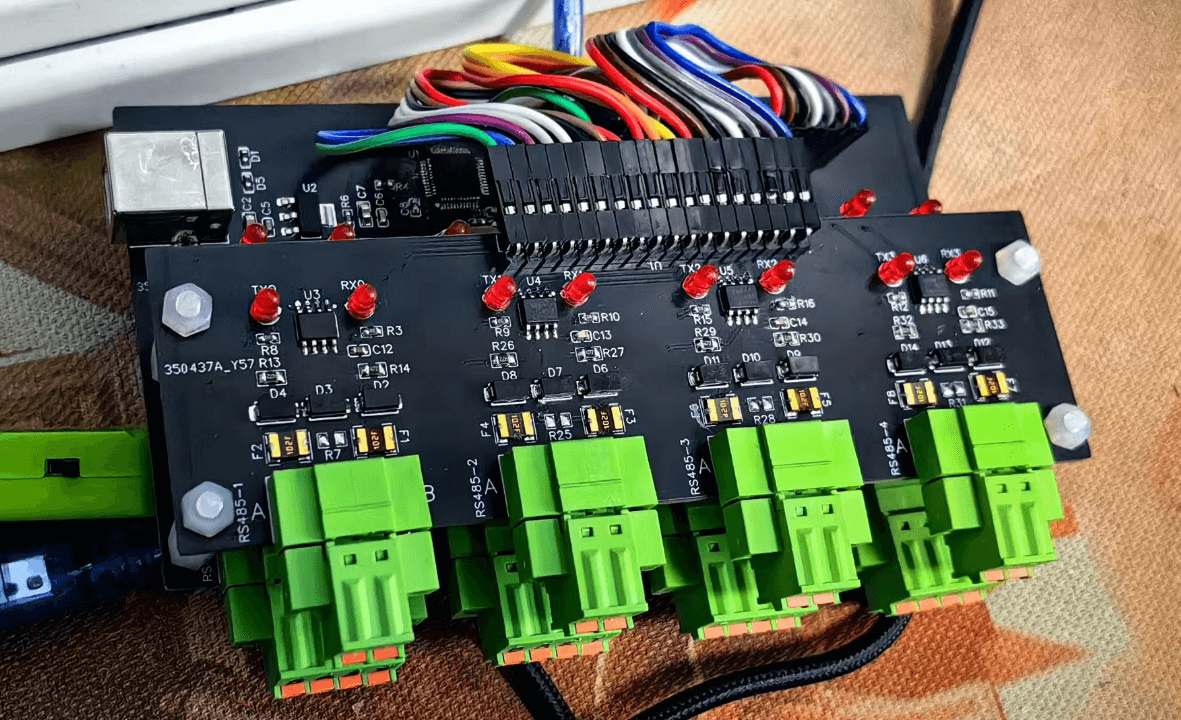创建一个 gp.PrimitiveSet 对象,对象名为 MAIN,自变量为 3
pset = gp.PrimitiveSet("MAIN", 3)
print(pset)
<deap.gp.PrimitiveSet object at 0x000001FBE182AB20>
gp.py(均为产生函数集与节点集)
PrimitiveSet
class PrimitiveSet(PrimitiveSetTyped):
"""Class same as :class:`~deap.gp.PrimitiveSetTyped`, except there is no
definition of type.
"""
def __init__(self, name, arity, prefix="ARG"): # 此时 name = MAIN, arity = 3,
# 创建 arity 个类对象,案例中为 3,
args = [__type__] * arity
PrimitiveSetTyped.__init__(self, name, args, __type__, prefix)

PrimitiveSetTyped
class PrimitiveSetTyped(object):
"""Class that contains the primitives that can be used to solve a
Strongly Typed GP problem. The set also defined the researched
function return type, and input arguments type and number.
"""
# name = MAIN,in_types=args(为每个变量创建的类组成的列表), ret_type = __type__(元类)
def __init__(self, name, in_types, ret_type, prefix="ARG"):
# 存储终端节点的字典
self.terminals = defaultdict(list)
# defaultdict(list) 为默认 value 为 list 的字典
self.primitives = defaultdict(list) # 后续可通过pset.primitives[pset.ret][i] 依次提取函数, .name 可查看函数名
self.arguments = []
# setting "__builtins__" to None avoid the context
# being polluted by builtins function when evaluating
# GP expression.
self.context = {"__builtins__": None}
self.mapping = dict()
# 存储终端节点个数
self.terms_count = 0
# 存储函数节点个数
self.prims_count = 0
# PrimitiveSet 类名
self.name = name
self.ret = ret_type # __type__(元类)
# 自变量集合
self.ins = in_types
for i, type_ in enumerate(in_types):
# 为每个自变量从 0 编号,如这里的 ARG0, ARG1, ARG2
arg_str = "{prefix}{index}".format(prefix=prefix, index=i)
# 将 arg_str 添加到 arguments 列表中
self.arguments.append(arg_str)
# 将每个自变量转换为终端节点类类型,
term = Terminal(arg_str, True, type_)
# 将 term 分为终端节点与函数节点,分别添加到 dict_ 中
self._add(term)
# 终端节点数 + 1
self.terms_count += 1
Terminal
class Terminal(object):
"""Class that encapsulates terminal primitive in expression. Terminals can
be values or 0-arity functions.
"""
__slots__ = ('name', 'value', 'ret', 'conv_fct')
def __init__(self, terminal, symbolic, ret):
self.ret = ret # 节点类型,__type__
self.value = terminal # ARG0
self.name = str(terminal) # 'ARG0'
self.conv_fct = str if symbolic else repr # 见详解 1 处
_add
def _add(self, prim):
def addType(dict_, ret_type):
if ret_type not in dict_:
new_list = []
for type_, list_ in list(dict_.items()):
if issubclass(type_, ret_type):
for item in list_:
if item not in new_list:
new_list.append(item)
dict_[ret_type] = new_list
addType(self.primitives, prim.ret) # primitives 函数节点组成的字典,prim.ret 当前传入的节点类型
addType(self.terminals, prim.ret) # self.terminals,终端节点组成的字典
self.mapping[prim.name] = prim # prim.name = ARG0
# 判断 prim 是否为 函数类型,即 Primitive
if isinstance(prim, Primitive): # isinstance 判断是否为同一类型
for type_ in prim.args:
addType(self.primitives, type_)
addType(self.terminals, type_)
dict_ = self.primitives
else:
# 否则为终端节点类型
dict_ = self.terminals
for type_ in dict_:
if issubclass(prim.ret, type_): # 判断 prim.ret 是否为 type_ 的子类
dict_[type_].append(prim) # 将 prim 添加到字典 dict_ 中
addPrimitive(PrimitiveSet)
# arity 函数参数个数,如-为2,+为2,log为1,exp为1, ariry=2,name='minus'
def addPrimitive(self, primitive, arity, name=None):
"""Add primitive *primitive* with arity *arity* to the set.
If a name *name* is provided, it will replace the attribute __name__
attribute to represent/identify the primitive.
"""
assert arity > 0, "arity should be >= 1"
# 参数产生的类的组合,比如这里 - 含有两个参数,则 args = [<class 'object'>, <class 'object'>]
args = [__type__] * arity
# primitive:定义的函数,args = [<class 'object'>, <class 'object'>], __type__ = 元类, name='minus'
PrimitiveSetTyped.addPrimitive(self, primitive, args, __type__, name)
addPrimitive(PrimitiveSetTyped)
# in_types = [<class 'object'>, <class 'object'>], ret_type = __type__(元类)
def addPrimitive(self, primitive, in_types, ret_type, name=None):
"""Add a primitive to the set.
:param primitive: callable object or a function.
:parma in_types: list of primitives arguments' type
:param ret_type: type returned by the primitive.
:param name: alternative name for the primitive instead
of its __name__ attribute.
"""
if name is None:
"""此处设置 name 参数,默认为定义时的函数名,如 def add(int a, int b), 则 name 默认为 add"""
name = primitive.__name__
prim = Primitive(name, in_types, ret_type)
assert name not in self.context or \
self.context[name] is primitive, \
"Primitives are required to have a unique name. " \
"Consider using the argument 'name' to rename your " \
"second '%s' primitive." % (name,)
# 判断 prim 是否从未被添加进 _dict 字典中,若没有,则添加进去
self._add(prim)
self.context[prim.name] = primitive # 用于表示此名称的节点为函数节点
self.prims_count += 1 # 函数节点个数 + 1
Primitive
class Primitive(object):
"""Class that encapsulates a primitive and when called with arguments it
returns the Python code to call the primitive with the arguments.
>>> pr = Primitive("mul", (int, int), int)
>>> pr.format(1, 2)
'mul(1, 2)'
"""
# 定义实例化此类后能访问的属性,元组以外的属性均不可访问
__slots__ = ('name', 'arity', 'args', 'ret', 'seq')
def __init__(self, name, args, ret):
self.name = name # 函数名,minus
self.arity = len(args) # 参数个数,2
self.args = args # 参数个数定义的类组成的集合,[<class 'object'>, <class 'object'>]
self.ret = ret # 当前类属性 <class 'object'>
args = ", ".join(map("{{{0}}}".format, list(range(self.arity)))) # 为每个参数编号, args = '{0}, {1}'
# 'minus({0}, {1})'
self.seq = "{name}({args})".format(name=self.name, args=args)
小技巧
# 在函数集中随便选择一个,
prim = random.choice(pset.primitives[type_]) # type_ = pset.ret
# 在终点集中随机选择一个节点
term = random.choice(pset.terminals[type_])
- type_ = pset.ret:表示原语集合的类型
- pset.primitives:函数集,用字典表示
pset.ret # <class 'object'>
pset.primitives # 函数集,字典类型
pset.primitives[pset.ret] # 在字典类型中提取 pset.ret(<class 'object'>),即可得到所有函数集中的函数集合
# 寻找所有函数组成的列表中,函数名 == "add",对应的索引位置,通常会返回一个列表,比如[1], 通过在代码最后加一个[0]提取, 即可得到 1 这个值
index = [primitive_index for primitive_index in range(len(pset.primitives[pset.ret])) if pset.primitives[pset.ret][primitive_index].name == "add"]
提取所有终端节点,返回一个所有终端节点组成的集合
pset.terminals # # 终端集,字典类型
pset.terminals[pset.ret]
提取以 Node 索引对应的节点为根节点的子树
tree=PrimitiveTree(genHalfAndHalf(pset, 1, 3))
for Node in range(len(tree)):
tree[tree.searchSubtree(Node)] # tree.searchSubtree(Node) 返回的是一个切片 slice
获取函数集中第 i 个加入到函数集中的函数的函数名:
pset.primitives[pset.ret][i].name
所有的自变量组成的列表,[ARG0, ARG1, …]
pset.arguments
详解 1
这是一个Python中的三元表达式(ternary expression),用于根据条件选择不同的表达式。在这个三元表达式中,str和repr是Python中的两个内置函数,分别用于将对象转换为字符串和计算对象的可打印表示。symbolic是一个条件,如果为True,则选择str,否则选择repr。
具体来说,这个三元表达式的意义是:
如果symbolic为True,则返回一个字符串表示;否则返回对象的可打印表示。
示例代码:
x = 10
symbolic = True
result = str(x) if symbolic else repr(x)
print(result) # 输出 '10'
在上面的代码中,由于symbolic为True,所以选择了str(x),即将x转换为字符串'10'。因此,result的值为'10'。
如果将symbolic改为False,则会选择repr(x),即返回x的可打印表示:
x = 10
symbolic = False
result = str(x) if symbolic else repr(x)
print(result) # 输出 '10'
在这个例子中,由于symbolic为False,所以选择了repr(x),即返回x的可打印表示10。因此,result的值为10。
终端节点参数:
- ret:节点的类型
- value:节点值
- name:节点名称
- conv_fct:节点信息显示
整体代码
import random
import numpy
from deap import gp, creator, base, tools
def minus(left,right):
return numpy.subtract(left,right)
pset = gp.PrimitiveSet("MAIN", 3)
print(pset)
pset.addPrimitive(minus, 2, 'minus')
pset.renameArguments(ARG0='x0')
# 定义terminal set
pset.addTerminal(3) # 常数
pset.addEphemeralConstant('num',lambda:random.randint(-5,5)) # 随机数:(name,随机数函数)
# 三种生成方法,full,grow,half(primitive set,min_depth,max_depth)
# Deap 框架中树的最大深度是91, 最小深度是0(只有一个叶子节点)
expr1 = gp.genFull(pset, 1, 3) # list
expr2 = gp.genGrow(pset, 1, 3)
expr3 = gp.genHalfAndHalf(pset, 1, 3)
tree = gp.PrimitiveTree(expr1) # 将表达式形式转换成树形结构
# 编译表达式:必须经过编译才能进行运算
function1 = gp.compile(tree, pset)
# function2 = gp.compile(expr2,pset)
result = function1(1, 2) # 输入变量值能够得到该表达式的结果
print('result:', result)
gp.genFull、gp.genGrow、gp.genHalfAndHalf
gp.genFull:产生一棵满二叉树,树高等于树的深度时停止产生树,先从函数集中选择,当树高等于树的深度时,再从终端集中进行选择,最终选出的节点顺序存储在列表中。整体为一个类结构:[<deap.gp.Primitive object at 0x0000026F49035D10>, <deap.gp.Primitive object at 0x0000026F49035D10>, <deap.gp.Primitive object at 0x0000026F49035D10>, <deap.gp.num object at 0x0000026F4903C270>, <deap.gp.Terminal object at 0x0000026F49038880>,- 注: 三个方法最终返回的都是一个列表,列表依次存储了树形结构的节点
def genFull(pset, min_, max_, type_=None):
"""Generate an expression where each leaf has the same depth
between *min* and *max*.
:param pset: Primitive set from which primitives are selected.
:param min_: Minimum height of the produced trees.
:param max_: Maximum Height of the produced trees.
:param type_: The type that should return the tree when called, when
:obj:`None` (default) the type of :pset: (pset.ret)
is assumed.
:returns: A full tree with all leaves at the same depth.
"""
def condition(height, depth): # 终止条件:产生树的节点深度恰好等于树高
"""Expression generation stops when the depth is equal to height."""
return depth == height
return generate(pset, min_, max_, condition, type_)
generate
def generate(pset, min_, max_, condition, type_=None):
"""创建一颗树:树中的节点均存储在列表中,当满足 condition 条件时停止.
:param pset: Primitive set from which primitives are selected.
:param min_: 产生的树的最小高度
:param max_: 产生的树的最大高度
:param condition: The condition is a function that takes two arguments,
the height of the tree to build and the current
depth in the tree.
:param type_: 返回树的类型,默认应该为 pset: (pset.ret)
:returns: A grown tree with leaves at possibly different depths
depending on the condition function.
"""
if type_ is None:
type_ = pset.ret # pset.ret 为节点类别 <deap.gp.PrimitiveSet object at 0x000001C5DC245160>
expr = [] # 将在函数集与终端集选出的节点放入到 expr 中
height = random.randint(min_, max_) # 定义树高:从最小深度与最大深度之间随机选择一个值
stack = [(0, type_)] # 利用栈结构来产生树结构,初始时深度为 0,节点为 type_ 类型
while len(stack) != 0:
depth, type_ = stack.pop()
if condition(height, depth):
try:
# =在终点集中随机选择一个节点
term = random.choice(pset.terminals[type_])
except IndexError:
_, _, traceback = sys.exc_info()
raise IndexError("The gp.generate function tried to add " \
"a terminal of type '%s', but there is " \
"none available." % (type_,)).with_traceback(traceback)
if isclass(term): # 需要判断是否为一个类类型
term = term()
expr.append(term) # 将选出的终点集添加进去
else:
try:
prim = random.choice(pset.primitives[type_]) # 从函数集中随机选择一个节点
except IndexError:
_, _, traceback = sys.exc_info()
raise IndexError("The gp.generate function tried to add " \
"a primitive of type '%s', but there is " \
"none available." % (type_,)).with_traceback(traceback)
expr.append(prim) # 将选出的函数添加到 expr 中
for arg in reversed(prim.args): # 遍历函数参数类
stack.append((depth + 1, arg)) # 添加到栈中,后续产生更深的树
return expr # 由许多节点组成的列表
gp.PrimitiveTree(产生树结构)
将:[<deap.gp.Primitive object at 0x0000026F49035D10>, <deap.gp.Primitive object at 0x0000026F49035D10>, <deap.gp.Primitive object at 0x0000026F49035D10>, <deap.gp.num object at 0x0000026F4903C270>, <deap.gp.Terminal object at 0x0000026F49038880>, <deap.gp.Primitive object at 0x0000026F49035D10>, <deap.gp.Terminal object at 0x0000026F49038740>, <deap.gp.Terminal object at 0x0000026F49038880>, <deap.gp.Primitive object at 0x0000026F49035D10>, <deap.gp.Primitive object at 0x0000026F49035D10>, <deap.gp.Terminal object at 0x0000026F49038740>, <deap.gp.num object at 0x0000026F4903C360>, <deap.gp.Primitive object at 0x0000026F49035D10>, <deap.gp.Terminal object at 0x0000026F49038740>, <deap.gp.Terminal object at 0x0000026F49038740>]
转化为: minus(minus(minus(-1, 3), minus(ARG1, 3)), minus(minus(ARG1, 1), minus(ARG1, ARG1)))
gp.compile(tree, pset)
def compile(expr, pset):
"""Compile the expression *expr*.
:param expr: Expression to compile. It can either be a PrimitiveTree,
a string of Python code or any object that when
converted into string produced a valid Python code
expression.
:param pset: Primitive set against which the expression is compile.
:returns: a function if the primitive set has 1 or more arguments,
or return the results produced by evaluating the tree.
"""
code = str(expr)
if len(pset.arguments) > 0:
# This section is a stripped version of the lambdify
# function of SymPy 0.6.6.
args = ",".join(arg for arg in pset.arguments)
code = "lambda {args}: {code}".format(args=args, code=code)
try:
return eval(code, pset.context, {})
except MemoryError:
_, _, traceback = sys.exc_info()
raise MemoryError("DEAP : Error in tree evaluation :"
" Python cannot evaluate a tree higher than 90. "
"To avoid this problem, you should use bloat control on your "
"operators. See the DEAP documentation for more information. "
"DEAP will now abort.").with_traceback(traceback)
这段代码实现了一个编译函数compile,用于将表达式编译为可执行的Python代码。函数接受两个参数:expr表示要编译的表达式(一个列表),pset表示该表达式所使用的原语集合。
如果pset中定义了一个或多个参数,编译后的代码将会被包装在一个lambda函数中,并使用原语集合中定义的参数名称。否则,编译后的代码将会直接执行。
在编译完成后,函数使用eval函数将代码字符串转换为可执行的Python代码,并在pset.context命名空间中执行它。如果编译过程中出现内存错误,函数会抛出一个MemoryError异常,并显示相关错误信息。最终,函数返回一个可执行的Python函数或表达式的求值结果。
这个函数实现了将表达式编译成可执行的Python代码的功能,可以用于在遗传算法或其他优化算法中对表达式进行求解。函数接受两个参数:
-
expr:要编译的表达式,可以是一个PrimitiveTree对象、一个Python代码字符串,或者任何能够被转换为有效Python代码表达式的对象。
-
pset:表达式使用的原语集合。原语集合是一个包含基本运算符、函数、常量和变量的集合,用于构建表达式。
如果原语集合中定义了参数,则编译的代码将会被封装在一个lambda函数中,并使用原语集合中定义的参数名称。否则,编译后的代码将会直接执行。最后,函数使用eval函数将代码字符串转换为可执行的Python代码,并在pset.context命名空间中执行它。如果编译过程中出现内存错误,函数会抛出一个MemoryError异常,并显示相关错误信息。
函数的返回值取决于原语集合中是否定义了参数。如果原语集合中定义了一个或多个参数,则函数将返回一个可执行的Python函数。否则,函数将返回表达式求值的结果。
searchSubtree
def searchSubtree(self, begin):
"""Return a slice object that corresponds to the
range of values that defines the subtree which has the
element with index *begin* as its root.
"""
end = begin + 1
total = self[begin].arity
while total > 0:
total += self[end].arity - 1
end += 1
return slice(begin, end)
Toolbox
register
def register(self, alias, function, *args, **kargs):
"""
>>> def func(a, b, c=3):
... print a, b, c
...
>>> tools = Toolbox()
>>> tools.register("myFunc", func, 2, c=4)
>>> tools.myFunc(3)
2 3 4
"""
pfunc = partial(function, *args, **kargs) #
pfunc.__name__ = alias
pfunc.__doc__ = function.__doc__
if hasattr(function, "__dict__") and not isinstance(function, type):
# Some functions don't have a dictionary, in these cases
# simply don't copy it. Moreover, if the function is actually
# a class, we do not want to copy the dictionary.
pfunc.__dict__.update(function.__dict__.copy())
setattr(self, alias, pfunc)
References
[1] 【Python】详解类的 repr() 方法
[2] python slots 详解(上篇)


















